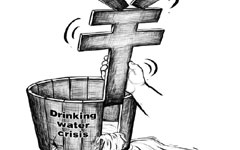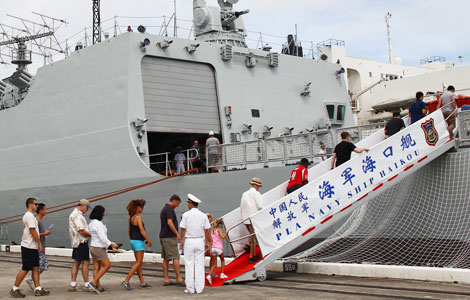China's arid north feeds water-rich south
Updated: 2014-07-08 11:41
(Agencies)
|
||||||||
Booming demand for food in China's southern and eastern cities is worsening water shortages in arid northern provinces, adding to the country's environmental problems, new research shows.
"Consumption in highly developed coastal provinces is largely relying on water resources in the water-scarce northern provinces, such as Xinjiang, Hebei and Inner Mongolia, thus significantly contributing to the water scarcity in these regions," an international group of researchers wrote in the latest edition of the journal Environmental Science and Technology.
"Rich coastal provinces gain economic profits from international exports at the expense of ecosystem quality in the less developed regions," the researchers from the University of Maryland and the International Institute for Applied Systems Analysis concluded ("Virtual Scarce Water in China" June 2014).
|
 |
 |
But these provinces have experienced the fastest industrialization and urbanization since reform and opening in 1979. Large amounts of farm land have been converted to industrial and residential use.
In response, much of the country's agricultural production has been pushed north and inland to regions with much less rain.
Terms of trade
Some 109 billion cubic meters of water was traded between Chinese provinces in 2007, mostly in the form of "virtual water" contained in fresh and processed foods.
The main virtual flows are from agricultural regions like Xinjiang, Inner Mongolia, Hebei, Ningxia and Gansu to the megacities of Beijing, Tianjin, Shanghai and Chongqing, as well as the heavily industrialized provinces of Shandong, Zhejiang and Guangdong along the east coast.
Water flows demonstrate the 19th century British economist David Ricardo's theory of comparative advantage. China's southern provinces have advantages over the north in both industry and agriculture. But their comparative advantage is greater in industry, so the south has specialized in industrial production and forced the north to specialize in farming.
As provinces and cities along the eastern seaboard have become ever more dominant industrially, farm production has been driven into the drier areas of the north and west.
The key change over the last three decades, as the researchers explain, is that the south has become much better at industrial production, rather than the north becoming better agriculture.

 'God father' of HK art honored for Smithsonian exhibit
'God father' of HK art honored for Smithsonian exhibit
 Grateful blessings
Grateful blessings
 Visitors tour Chinese warships
Visitors tour Chinese warships
 Chinese-American police officers rise in NYPD
Chinese-American police officers rise in NYPD
 The world in photos: June 30 - July 6
The world in photos: June 30 - July 6
 Chinese navy to join 2014 RIMPAC naval drill
Chinese navy to join 2014 RIMPAC naval drill
 Gettysburg reenactment marks 151st anniversary
Gettysburg reenactment marks 151st anniversary
 Washington splashed with fireworks
Washington splashed with fireworks
Most Viewed
Editor's Picks

|

|

|

|

|

|
Today's Top News
Chinese envoy: 'Time is ripe' for BRICS' bank
US south benefitting from China investment
Talks may help US soy exports
Product placement deal transforms into dispute
China approves Lenovo, IBM $2.3b server deal
Meet the new breed of migrant workers
NetJets awaits green light to start China operations
Unleashing the power of innovation
US Weekly

|

|







